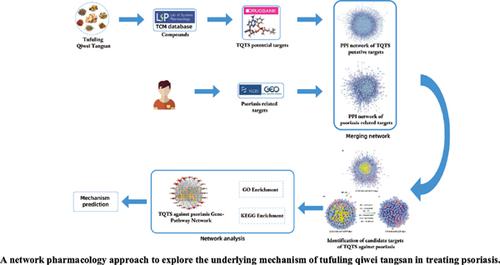Current Bioinformatics ( IF 4 ) Pub Date : 2021-06-30 , DOI: 10.2174/1574893616666210315093639 Xiaolei Ma 1 , Yinan Lu 1 , Yang Lu 2 , Zhili Pei 2

|
Background: Tufuling Qiwei Tangsan (TQTS) is a commonly used Mongolian medicine preparation against psoriasis in China. However, its mechanism of action and molecular targets for the treatment of psoriasis is still unclear. Network pharmacology can reveal the synergistic mechanism of drugs at the molecular, target, and pathway levels and is suitable for the complex study of traditional Chinese medicine formulations. However, it is rarely involved in the application of Mongolian medicine with the same holistic concept of traditional Chinese medicine.
Methods: In this paper, the active compounds of TQTS were collected, and their targets were identified. Psoriasis-related targets were obtained by analyzing the differential expressed genes between psoriasis patients and healthy individuals. Then, the network concerning the interactions of potential targets of TQTS with well-known psoriasis-related targets was built. The core targets were selected according to topological parameters. And the enrichment analysis was carried out to explore the mechanism of action of TQTS. Moreover, molecular docking was performed to study the interaction between the selected ligands and receptors related to psoriasis.
Result and Conclusion: Eighty-five active compounds of TQTS were screened, with corresponding 270 targets, and 313 differentially expressed genes were identified. Additionally, enrichment analysis showed that the targets of TQTS for treating psoriasis were mainly involved in multiple biological processes, including apoptosis, growth factor response, etc., and related pathways including PI3K-Akt and MAPK signaling pathway, and so on. Genes such as NFKB1, TP53, and MAPK1 are the key genes in the gene pathway network of TQTS against psoriasis. The 4 main active components of TQTS have certain binding activity with 13 potential targets, and the stability of their interaction with AKT1 is found to be the most efficient, which indicates the potential mechanism of TQTS on psoriasis.
中文翻译:

探讨土茯苓七味汤散治疗银屑病潜在机制的网络药理学方法
背景:涂复灵七味汤散(TQTS)是国内常用的治疗银屑病的蒙药制剂。然而,其治疗银屑病的作用机制和分子靶点尚不清楚。网络药理学可以在分子、靶点和通路水平上揭示药物的协同作用机制,适用于中药制剂的复杂研究。但与中医整体观念相同的蒙医应用却鲜有涉及。
方法:本文收集了TQTS的活性化合物,并对其作用靶点进行了鉴定。通过分析银屑病患者与健康个体差异表达基因,获得银屑病相关靶点。然后,建立了关于 TQTS 潜在目标与众所周知的银屑病相关目标相互作用的网络。根据拓扑参数选择核心目标。并通过富集分析探索TQTS的作用机制。此外,还进行了分子对接以研究所选配体和与银屑病相关的受体之间的相互作用。
结果与结论:筛选出TQTS活性化合物85个,对应靶点270个,鉴定出差异表达基因313个。此外,富集分析表明,TQTS治疗银屑病的靶点主要涉及多个生物学过程,包括细胞凋亡、生长因子反应等,相关通路包括PI3K-Akt和MAPK信号通路等。NFKB1、TP53、MAPK1等基因是TQTS抗银屑病基因通路网络中的关键基因。TQTS的4种主要活性成分与13个潜在靶点具有一定的结合活性,且与AKT1相互作用的稳定性最为有效,表明TQTS对银屑病的潜在作用机制。



























 京公网安备 11010802027423号
京公网安备 11010802027423号